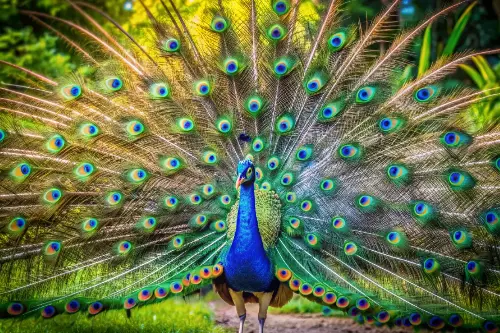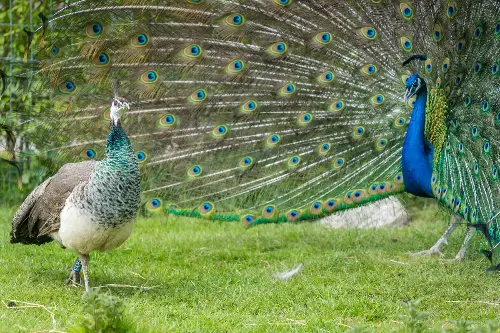The peacock, a symbol of beauty and courtship, commands attention with its extravagant plumage and elegant display. With an eye-catching array of iridescent feathers, this majestic bird is renowned for its remarkable tail, which fans out in a dazzling spectacle of colour and pattern. Let's delve into the peafowl's world and uncover the secrets behind nature's most impressive exhibition of feathers.

The Biology behind the Brilliance
Understanding the peacock's splendour begins with biology. Peafowl is a term encompassing three species, but it's the males of the Pavo cristatus species, commonly known as Indian Peafowl or Blue Peafowl, that are famous for their vibrant tail feathers, or train. This train accounts for more than 60% of the peacock's total body length and is not their true tail, which is brown and short, but rather their upper-tail coverts.
These elongated feathers are adorned with patterns known as "eyes," capable of an optical illusion known as iridescence. This visual phenomenon occurs due to microscopic structures in the feathers that refract light, producing the vivid colours that change and shimmer as the angle of light shifts. It results in the mesmerising blues, greens, and other hues that give the peacock its regal attire.
Courtship and Competition
The primary purpose of the peacock's train is courtship. During the mating season, which peaks in the spring, males assemble in the breeding grounds known as leks. Here, they compete with each other to attract mates through an elaborate show of their feathered finery, which includes vibrating feathers to create a rustling sound and a display posture aimed at highlighting the extravagance of their tails.
Studies have shown that the size and vibrancy of the display are directly tied to a peacock's reproductive success. Females, or peahens, tend to prefer males with longer, more colourful trains, as they indicate a healthy and genetically robust potential mate.

The Science of Sight
It's not just the size and it's not just the dance; the eyespots on the peacock's train have their own story to tell. Peahens are believed to look for particular qualities within these eyespots when selecting a mate. Research has found that peahens position themselves directly behind the displaying peacock to scrutinise the lower eyespots closely.
However, the peahen's gaze isn't just drawn to any eyespot. It's the quality that matters. Larger, more symmetrical eyespots with vivid colouring are the most attractive features, as they might indicate an absence of parasites and a strong immune system in the displaying male.
A Symbol Beyond Mating
While the peacock's display is rooted in reproductive dynamics, it has also given rise to numerous cultural and religious symbolisms throughout history. Representing everything from royalty and nobility to immortality and renewal, the peacock has inspired artworks, stories, and spiritual motifs across civilisations.
In Hindu mythology, the peacock is associated with the goddess Saraswati and the warrior god Kartikeya. In Christianity, it is often seen as a symbol of eternal life, and in ancient Greek and Roman mythology, it was linked to the goddess Hera, who gave the peacock its eyes as a gift.
Feathers in Fashion
Historically, peacock feathers have been used in fashion and decor, coveted for their beauty. While it adds a flamboyant touch to human couture, there's a price to this appropriation. The demand for feathers can lead to unethical practices, and thus knowledge and respect for the bird's welfare must guide the aesthetic use of its features.
Predation and the Peacock
One might expect that sporting such conspicuous plumage could make peacocks an easy target for predators. However, they have adapted to counter this disadvantage with sharp eyesight and the ability to fly, albeit not long distances, to escape ground threats. Moreover, their vibrant train can be shed rapidly as an evasion tactic, leaving a predator with a mouthful of feathers while the bird flees.
Conservation Concerns
Despite their prominent cultural presence, peacocks face challenges due to loss of habitat and hunting. Conservation efforts are crucial to ensure that their natural habitats are protected and that populations remain stable. Being mindful of their ecological impact and supporting wildlife sanctuaries can contribute to the survival of these magnificent birds, allowing future generations to witness their ornate displays.
In essence, the peacock's feathers are not just a natural masterpiece; they're a complex combination of biology, evolution, and ecological adaptation. This charismatic creature continues to fascinate and inspire us with its dynamic display, serving as a reminder of the intricate beauty that wildlife has to offer. Whether seen as a marvel of courtship or a template for art and myth, the peacock stands as a testament to nature's ability to conjure awe through its most dazzling display of feathers.
